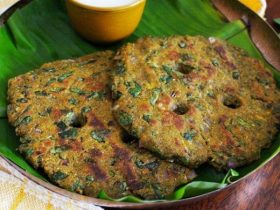Tamarind rice, also known as puliyogare, is a traditional South Indian meal that is well-known for its strong, fragrant, and tart characteristics. The Tamil terms Ogare (meaning “seasoned rice”) and Puli (meaning “sour” or “tamarind”) are the source of the name.
Pulihora in Andhra Pradesh, Puliyogare Gojju in Karnataka, Puliyodharai in Tamil Nadu, Imli Rice in Hindi, Melkote Iyengar Puliogare, and Temple-style Puli Sadam are some of the regional variations of this adaptable meal.
Notwithstanding these variations, the basic concept is still the same: rice that has been cooked to perfection and is flavored with a blend of spices and a tart tamarind foundation.
History And Cultural Significance
Tamarind rice, also known as puliyodharai, is a beloved South Indian cuisine with a long history. It represents dedication and tradition and is frequently made during festivals and served as prasad in temples. It has a significant role in South Indian homes and festive occasions, alongside foods like Curd Rice, Lemon Rice, and Sweet Pongal.
Because of its natural preservation properties and tangy, spicy flavors, puliyodharai keeps well for extended periods of time, making it perfect for picnics, travel, and packed lunches. Its adaptability enables personalization, and regional variations, such as Andhra’s Pulihora or Iyengar-style Puliyodharai, give this traditional meal distinctive twists.
Kovil Puliyodharai’s eternal appeal is ensured by its skillful blending of history, functionality, and robust flavors. source
Tamarind Rice: Health Benefits
In addition to being delicious, tamarind rice has a number of health advantages.
- Antioxidant-Rich: Tamarind is a great source of vitamins and antioxidants that help strengthen immunity and combat free radicals.
- Aids Digestion: Tamarind’s natural acids promote gut health and aid with digestion.
- Controls Blood Sugar: Tamarind has long been used to help control blood sugar levels.
- Cooling Effect: Tamarind rice is thought to provide a cooling effect on the body in the hot heat of South India.
- Good for Heart Health: Curry leaves and mustard seeds are two spices that are good for the heart.
Ingredients

The distinctive combination of ingredients that gives tamarind rice its distinctively sour and spicy flavor is what makes it so special. The main elements consist of:
- Rice: Because of its capacity to absorb flavors, short-grain rice is usually chosen.
- The distinctive tanginess is provided by the tamarind.
- Seasonings & Spices: The aromatic profile is enhanced by asafoetida, curry leaves, dried red chilies, and mustard seeds.
- Nuts with Lentils: Peanuts, urad dal, and chana dal offer a nutty taste and texture.
- Sesame Oil: Boosts the genuine flavor and scent.
- 2 cups cooked rice (preferably cooled)
- 2 tbsp tamarind pulp
- 1 tbsp sesame seeds
- 1 tbsp jaggery (optional, for sweetness)
- 1 tsp mustard seeds
- 1 tsp turmeric powder
- 2 tbsp oil (preferably sesame oil)
- 1 tsp chana dal (Bengal gram)
- 1 tsp urad dal (black gram)
- 2 dried red chilies
- 8-10 curry leaves
- ¼ tsp asafoetida (hing)
- 2 tbsp peanuts
- Salt to taste.
Tamarind Rice Recipe

Step 1: To make tamarind extract, soak the tamarind for around fifteen minutes in warm water. To get a thick tamarind extract, squeeze out the pulp and sieve. Put aside.
Step 2: Heat the sesame oil in a skillet over medium heat to temper the spices. Let the mustard seeds sputter after adding them. Next, include asafoetida, curry leaves, dried red chilies, urad dal, and chana dal. The dals should be sautéed till golden brown.
Step 3: Add tamarind essence: Fill the pan with the tamarind essence. Add salt and turmeric powder. Stir thoroughly and simmer until the oil begins to separate and the mixture thickens. Often called “Puliyodharai paste,” this concentrated combination can be kept for further use.
Step 4: Mix with Rice: Pour the tamarind sauce over the cooked rice. Mix gently until the tamarind paste coats every grain of rice. To keep the rice from getting mushy, make sure it has chilled.
Step 5: Add Peanuts: Gently stir the roasted peanuts into the rice.
Step 6: Rest Before Serving: Before serving, let the tamarind rice sit for at least half an hour. The tastes are able to combine during this resting time, improving the flavor profile overall.
Summary!
Tamarind rice is a cultural experience rather than only a food. It is popular among all ages due to its acidic, spicy, and somewhat sweet qualities. In Indian cuisine, tamarind rice is a staple that can be prepared at home, as a festival prasad, or as a travel food.
Have you ever tried any tamarind rice recipe before? What do you think about this recipe of ours? Make sure to share your opinions!
Also Read: A2 Ghee – Nutrition, Benefits And Storage (5 Ideas Inside)
Follow Us: Facebook | Instagram | Twitter | Pinterest













Leave a Reply